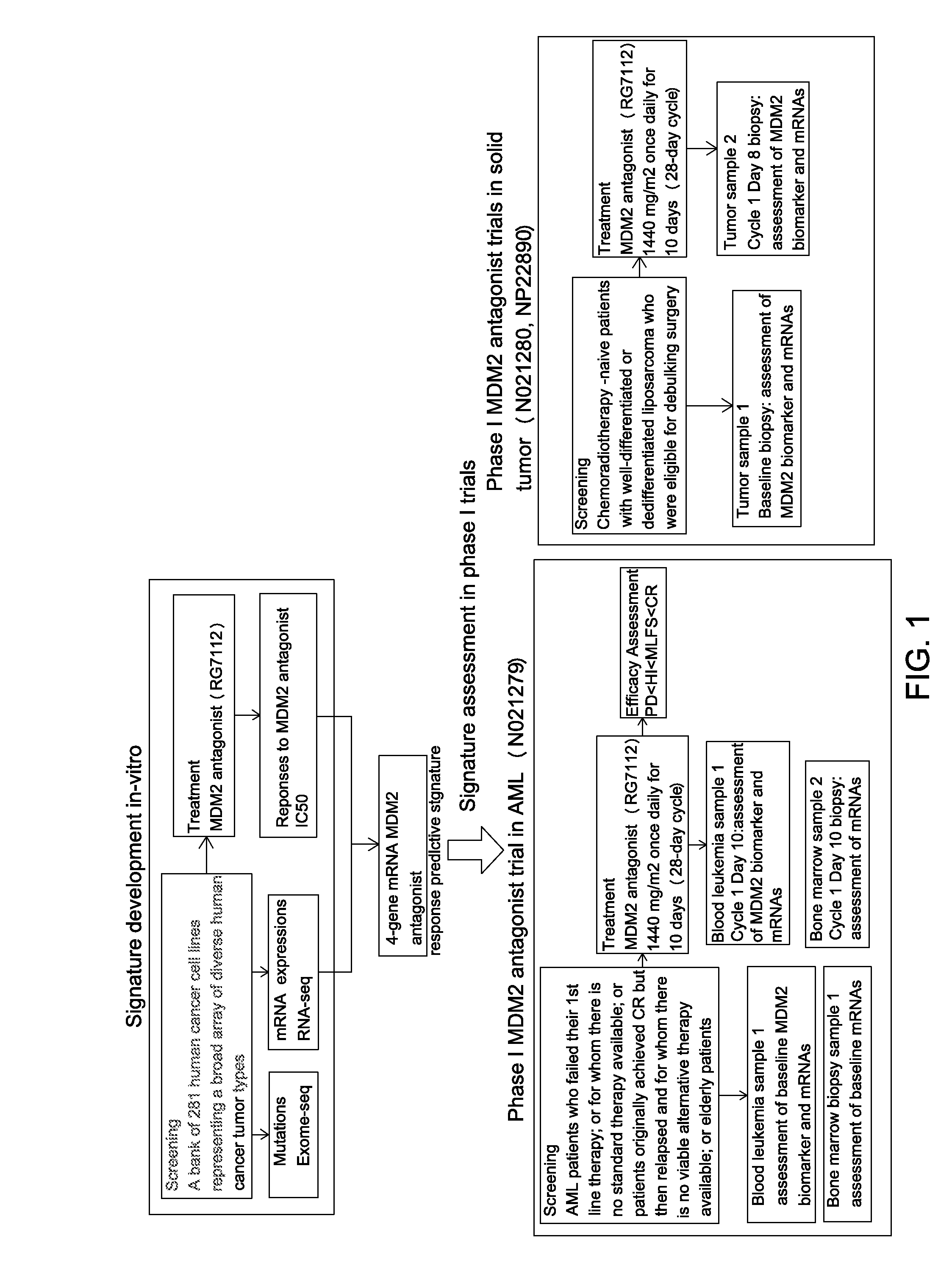Mrna-based gene expression for personalizing patient cancer therapy with an MDM2 antagonist
a technology of mrna-based gene expression and patient cancer therapy, which is applied in the direction of heterocyclic compound active ingredients, biocide, nucleotide libraries, etc., can solve the problems of inefficient growth arrest and apoptosis, and complicate the interpretation of tp53 mutational tests
- Summary
- Abstract
- Description
- Claims
- Application Information
AI Technical Summary
Benefits of technology
Problems solved by technology
Method used
Image
Examples
example 1
RNA Sequencing of CELLO Cell Lines
[0298]RNA sequencing (RNA-seq) by Next Generation Sequencing (NGS) technology is an accurate and sensitive approach to measure gene expression, with the additional power to detect alternative splicing, allele specific expression, non-coding RNA, and various forms of mutations (SNPs, indels, gene fusions). The NGS Illumina HiSeq machine generates raw base calls in reads of 50 or 100 bp length, which are subjected to several data analysis steps. The RNA-seq is conducted at 40 to 50 million reads per sample. This number provides relatively high sensitivity to detect low-expressed genes while allowing for cost-effective multiplexing of samples. RNA is prepared by standard kits and RNA libraries by polyA TruSeq Illumina kits. 100 ng of mRNA per cell line is used for each RNA-seq reaction. A number of quality control procedures are applied to the RNA-seq data for each sample. The Illumina HiSeq software reports the total number of clusters (DNA fragments)...
example 2
Exom-Sequencing of CELLO Cell Lines
[0300]Genomic DNA was extracted from the cells with DNeasy® Blood & Tissue Kit (Qiagen), followed by exome capture using the Roche NimbleGen SeqCap EZ Human Exome Library v2.0 (HG19). The captured libraries were then sequenced on the Illumina HiSeq2000 platform according to the manufacturer's instructions. The resultant paired ends 100 bp reads were trimmed back to 87 bases to minimize low quality sequence stretches at the 3-prime end. Sequence reads were mapped to the HG19 human reference genome (downloaded from http: / / genome.ucsc.edu) using the Novoalign short read aligner version 2•07•18.22 Alignments were subsequently sorted with samtools version 0•1•16 and PCR duplicate removal was done with the Picard MarkDuplicates program.24,25 Read quality scores were recalibrated with Genome Analysis Toolkit (GATK) TableRecalibration walker.26 Local realignments were then performed with samtools calmd method to better discover SNVs around insertion / deleti...
example 3
In Vitro Assay Gene Expression Analysis Methods
[0306]Messenger RNA (mRNA) expression levels at baseline, prior to MDM2 antagonist therapy, are obtained via RNA sequencing (RNA-seq) and microarray measurement using GeneChip Human Genome U133 Plus 2.0 Array. Gene expression analysis of RNA-seq data is summarized here. First, the sequence reads are mapped to the reference human genome and to an additional database of splice junction fragments derived from known exon locations on the reference genome (Cufflinks software). These mapped reads are then combined to create discrete counts of reads (or sequenced bases) per gene. These gene expression counts are then normalized to equalize the total amount of RNA counts for each sample and corrected for gene / transcript length (RPKM). All genes with expression values less than RPKM=1 in all cell lines are removed (this is roughly equivalent to an expression level less than one copy of an RNA molecule per cell). Next, normalized gene counts are ...
PUM
 Login to View More
Login to View More Abstract
Description
Claims
Application Information
 Login to View More
Login to View More - R&D
- Intellectual Property
- Life Sciences
- Materials
- Tech Scout
- Unparalleled Data Quality
- Higher Quality Content
- 60% Fewer Hallucinations
Browse by: Latest US Patents, China's latest patents, Technical Efficacy Thesaurus, Application Domain, Technology Topic, Popular Technical Reports.
© 2025 PatSnap. All rights reserved.Legal|Privacy policy|Modern Slavery Act Transparency Statement|Sitemap|About US| Contact US: help@patsnap.com



